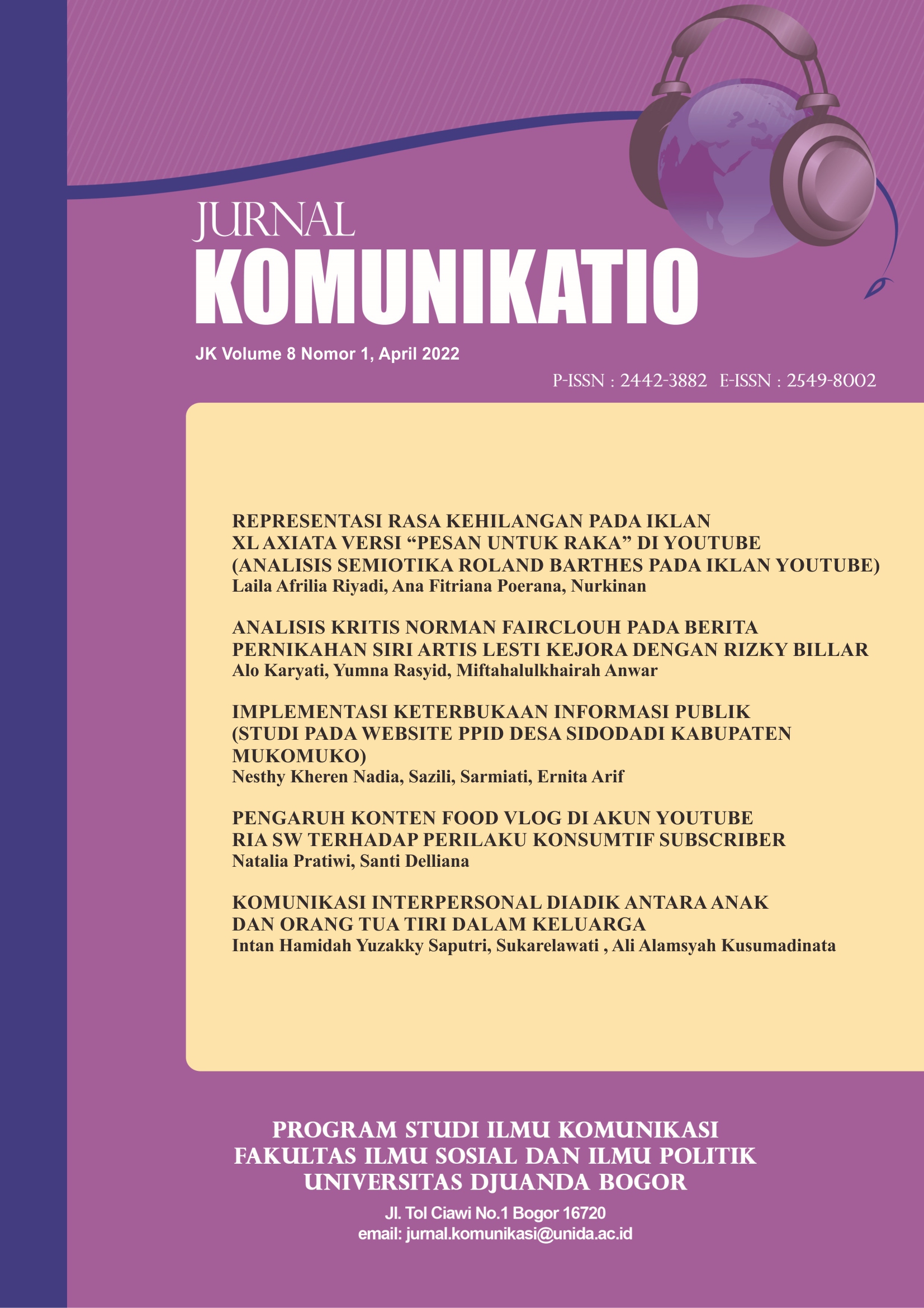KOMUNIKASI INTERPERSONAL DIADIK ANTARA ANAK DAN ORANG TUA TIRI DALAM KELUARGA
Main Article Content
Abstract
Communication between children and stepparents in the family is dyadic interpersonal communication. Dyadic communication is a type of communication that involves the relationship of two people. Dyadic interpersonal communication will be effective if the communication builds a shared understanding based on an attitude of openness, empathy, a supportive attitude or a positive attitude, and equality. This study examined dyadic interpersonal communication between children and stepparents in the family. The author used a qualitative descriptive method. The researchers collected primary data from interviews with five children who have stepparents. The study found the four elements of interpersonal communication in dyadic communication between children and stepparents. The element of openness was the most crucial factor in dyadic interpersonal communication between children and stepparents because it was the beginning of the presence of other aspects of effective communication. In addition, open communication can build positive, equal, and empathetic relationships.
Article Details

This work is licensed under a Creative Commons Attribution-ShareAlike 4.0 International License.
Authors who publish with Jurnal Komunikatio agree to the following terms:
- Authors retain copyright and grant the journal right of first publication with the work simultaneously licensed under a Creative Commons Attribution 4.0 International License that allows others to share the work with an acknowledgement of the work's authorship and initial publication in Jurnal Komunikatio.
- Authors are able to enter into separate, additional contractual arrangements for the non-exclusive distribution of the journal's published version of the work (e.g., post it to an institutional repository or publish it in a book), with an acknowledgement of its initial publication in Jurnal Komunikatio.
- Authors are permitted and encouraged to post their work online (e.g., in institutional repositories or on their website) prior to and during the submission process, as it can lead to productive exchanges, as well as earlier and greater citation of published work
References
Budyatna dan Leila Mona Ganiem. (2011). Teori Komunikasi Antarpribadi. Jakarta: Kencana.
Cangara, Hafied. (2015). Pengantar Ilmu Komunikasi. Jakarta: PT. RajaGrafindo Persada.
DeVito, Joseph A. (2011). Komunikasi Antar Manusia. Tanggerang: Karisma Publishing Group (Bahasa Indonesia).
Djalali, M. As’ad. Farida Yunistiati dan Muhammad Farid. (2014). Keharmonisan Keluarga, Konsep Diri dan Interaksi Sosial Remaja. Pesona. Jurnal Psikologi Indonesia. Vol. 3. No. 01.
Effendy, U. Onong. (2003). Ilmu Komunikasi Teori dan Praktik. Bandung: PT. Remaja Rosdakarya.
Erni, Amina. (2017). Komunikasi Interpersonal Keluarga Tentang Pendidikan Seks pada Anak Usia 1-5 Tahun. Jurnal Dakwah dan Komunikasi. Vol. 2 No. 1.
Lestari, S. S. (2016). Hubungan Keterbukaan Diri Dengan Penyesuaian Diri Mahasiswa Riau di Yogyakarta. E-Journal Bimbingan dan Konseling. Vol. 3. No. 5.
Lestari, Sri. (2012). Psikologi Keluarga Penanaman Nilai dan Penanganan Konflik dalam Keluarga. Jakarta: Kencana.
Liliweri. A. (2015). Komunikasi Antar-Personal. Jakarta: Kencana Prenada Media Group.
Morissan, dan Andy Corry Wardhany. (2013). Teori Komunikasi (Tentang Komunikator, Pesan, Percakapan, dan Hubungan). Bogor: Ghalia Indonesia.
Mufidah. (2013). Psikologi Keluarga Islam Berwawasan Gender. Malang: UIN-Maliki Press.
Mulyana, Deddy. (2008). Ilmu Komunikasi :Suatu Pengantar. Jakarta: PT Remaja Rosdakarya.
Nuruddin. (2005). Sistem Komunikasi Indonesia. Jakarta: PT. RajaGrafindo Persada.
Rachmawati, Tine Silvana. (2020). Peran Tenaga Kesehatan Pukesmas Sebagai Komunikator dalam Program Indonesia Sehat Dengan Pendekatan Keluarga. Jurnal Komunikasi Profesional. Vol. 4 No. 1.
Rasyid, M. A. (2015). Interpersonal Communication That Inspires in EFL Teaching. State University of Makassar, Indonesia.
Rizki, Mila Syafira. Ike Atikah Ratnamulyani dan Ali Alamsyah Kusumadinata. (2020). Perilaku Positif pada Komunikasi Antarpribadi dalam Tayangan Web Series Janji (Analisis Semiotika Charles Sanders Pierce). Jurnal Komunikatio. Vol. 6 No. 2.
Rohim, Syaiful. (2009). Teori Komunikasi (Perspektif, Ragam & Aplikasi). Jakarta: Rineka Cipta.
Ruliana, Poppy dan Puji Lestari. (2019). Teori Komunikasi. Depok: RajaGrafindo Persada.
Setiawan, Chaterine dan Suzy Azeharie. (2017). Studi Komunikasi Antarpribadi Anak Dengan Orang Tua Tiri. Jurnal Komunikasi. Vol. 9 N
Sukarelawati. (2018). Komunikasi Interpersonal Membentuk Sikap Remaja. Bogor: IPB Press.
Wood, Julia T. (2010). Komunikasi Interpersonal: Interaksi Keseharian. Terjemahan Rio Dwi Setiawan. Jakarta Selatan: Salemba Humanika.
